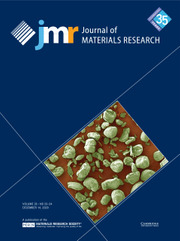Crossref Citations
This article has been cited by the following publications. This list is generated based on data provided by
Crossref.
Packard, C.E.
and
Schuh, C.A.
2007.
Initiation of shear bands near a stress concentration in metallic glass.
Acta Materialia,
Vol. 55,
Issue. 16,
p.
5348.
Iqbal, M.
Akhter, J.I.
Zhang, H.F.
and
Hu, Z.Q.
2008.
Synthesis and characterization of a multicomponent Fe-based bulk amorphous alloy.
Journal of Non-Crystalline Solids,
Vol. 354,
Issue. 52-54,
p.
5363.
Wu, F.‐F.
Zhang, Z.‐F.
Shen, B.‐L.
Mao, S. X.‐Y.
and
Eckert, J.
2008.
Size Effect on Shear Fracture and Fragmentation of a Fe57.6Co14.4B19.2Si4.8Nb4 Bulk Metallic Glass.
Advanced Engineering Materials,
Vol. 10,
Issue. 8,
p.
727.
Wu, F.F.
Zhang, Z.F.
Shen, J.
and
Mao, S.X.
2008.
Shear deformation capability of different metallic glasses.
Journal of Materials Research,
Vol. 23,
Issue. 10,
p.
2662.
Wang, G.
Chan, K.C.
Xu, X.H.
and
Wang, W.H.
2008.
Instability of crack propagation in brittle bulk metallic glass.
Acta Materialia,
Vol. 56,
Issue. 19,
p.
5845.
Fan, J.T.
Zhang, Z.F.
Mao, S.X.
Shen, B.L.
and
Inoue, A.
2008.
Nanocrystallization induced by quasi-static fracture of metallic glasses at room temperature.
Philosophical Magazine Letters,
Vol. 88,
Issue. 11,
p.
837.
Wang, J.‐G.
Zhao, D.‐Q.
Pan, M.‐X.
and
Wang, W.‐H.
2008.
Iron Based Alloy with Hierarchical Structure and Superior Mechanical Performance.
Advanced Engineering Materials,
Vol. 10,
Issue. 1-2,
p.
46.
Ai, Ke
and
Dai, LanHong
2008.
Numerical study of pile-up in bulk metallic glass during spherical indentation.
Science in China Series G: Physics, Mechanics and Astronomy,
Vol. 51,
Issue. 4,
p.
379.
Wang, J. G.
Zhao, D. Q.
Pan, M. X.
Shek, C. H.
and
Wang, W. H.
2009.
Mechanical heterogeneity and mechanism of plasticity in metallic glasses.
Applied Physics Letters,
Vol. 94,
Issue. 3,
Keryvin, V.
Hoang, V.H.
and
Shen, J.
2009.
Hardness, toughness, brittleness and cracking systems in an iron-based bulk metallic glass by indentation.
Intermetallics,
Vol. 17,
Issue. 4,
p.
211.
Guo, S.F.
Li, N.
Zhang, C.
and
Liu, L.
2010.
Enhancement of plasticity of Fe-based bulk metallic glass by Ni substitution for Fe.
Journal of Alloys and Compounds,
Vol. 504,
Issue. ,
p.
S78.
Zhang, Xinjian
Huang, Lu
Chen, Xu
Liaw, Peter K.
An, Ke
Zhang, Tao
and
Wang, Gongyao
2010.
Mechanical behavior of Fe75Mo5P10C7.5B2.5 bulk-metallic glass under torsional loading.
Materials Science and Engineering: A,
Vol. 527,
Issue. 29-30,
p.
7801.
Guo, S.F.
Liu, L.
Li, N.
and
Li, Y.
2010.
Fe-based bulk metallic glass matrix composite with large plasticity.
Scripta Materialia,
Vol. 62,
Issue. 6,
p.
329.
Zhao, J.X.
Wu, F.F.
Qu, R.T.
Li, S.X.
and
Zhang, Z.F.
2010.
Plastic deformability of metallic glass by artificial macroscopic notches.
Acta Materialia,
Vol. 58,
Issue. 16,
p.
5420.
Song, Min
Liao, Xiaozhou
and
He, Yuehui
2011.
Effect of sub-Tgannealing on the mechanical properties of a ZrAlNiCuNb bulk metallic glass.
Philosophical Magazine Letters,
Vol. 91,
Issue. 11,
p.
713.
Shi, Ling-ling
and
Xu, Jian
2011.
Mg based bulk metallic glasses: Glass transition temperature and elastic properties versus toughness.
Journal of Non-Crystalline Solids,
Vol. 357,
Issue. 15,
p.
2926.
Sun, Y.Y.
Song, M.
Liao, X.Z.
and
He, Y.H.
2011.
Mechanical properties of a FeCuSiB alloy with amorphous and/or crystalline structures.
Journal of Alloys and Compounds,
Vol. 509,
Issue. 23,
p.
6603.
Wu, F.F.
Zheng, W.
Wu, S.D.
Zhang, Z.F.
and
Shen, J.
2011.
Shear stability of metallic glasses.
International Journal of Plasticity,
Vol. 27,
Issue. 4,
p.
560.
Fan, H. B.
Zheng, W.
Wang, G. Y.
Liaw, P. K.
and
Shen, J.
2011.
Corrosion Behavior of Fe41Co7Cr15Mo14C15B6Y2 Bulk Metallic Glass in Sulfuric Acid Solutions.
Metallurgical and Materials Transactions A,
Vol. 42,
Issue. 6,
p.
1524.
Sun, B.R.
Qi, L.
and
Zhan, Z.J.
2013.
Microstructural dependence of mechanical properties in Hf-based bulk metallic glasses and their composites.
Journal of Alloys and Compounds,
Vol. 579,
Issue. ,
p.
315.

